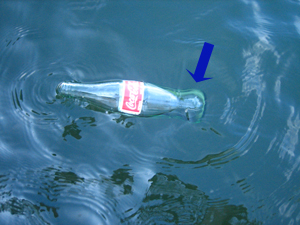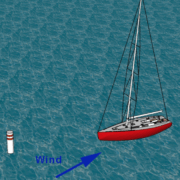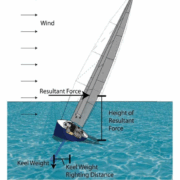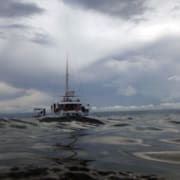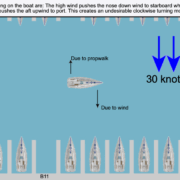Learning to sail in gusty conditions
Yesterday I was out teaching on our new Beneteau 373. The conditions were extremely gusty. Lake Travis in Austin Texas is a great lake for sailing all year round and in the summer the water is so incredibly warm that you can swim while anchored in a cove still at 2am. There are lots of coves and cliffs which makes for a picturess setting. Yet these cliffs and coves can set up extremely gusty conditions with wind shifts of 20 degrees of more about every 200 meters or so.
Sailing in these conditions can be a little challenging. A gust will hit and the boat will round up. Sometimes it rounds the boat all the way up so that you end up in an auto tack situation (tacking when you didn’t mean to). If there is other traffic on the lake this can be dangerous.
Here are a few tips to battle being rounded up so much.
(1) Reef
The reason the boat gets rounded up is that the center of pressure of the wind acting on the sails is too far aft.
The coke bottle in the water shows a force acting aft on the bottle. Which way would you expect the bottle to turn? This is the same as a sailboat. The front rounds up when the force is aft. Under normal conditions the rudder will balance the force, however in a gust condition the rudders ability to act back is not sufficient because the velocity of the rudder in the water is relatively lower than the gust. i.e. if the speed of the boat was higher the force out put by the rudder is higher. (Force is proportional to the square of the velocity). When a gust comes through the rudder is put at a disadvantage because the boat hasn’t gained the speed equivalent to handle the force aloft on the sails.
So the ABSOLUTE best way to handle these gusts is to reef the sails. This has a triple effect. Reefing obviously makes the forces aloft much smaller but also, not realized by many, is that when you reef the sails the center of effort of the wind on the boat must move forward. Additionally, the center of force aloft on the sails shifts downwards. This means the tipping moment is less. If the boat is healed over less then the rudder becomes more effective because the angle it presents to the water is more effective.
With the center of pressure on the sails moved forward, there is less turning moment on the boat. In the coke bottle example above if you moved the force arrow to the center of the bottle the bottle would not turn at all but merely be pushed through the water sideways. Reefing the sails then has the same effect and allows the rudder to overcome the turning moment.
(2) Tighten the outhaul. A tight outhaul flattens the mainsail. Flattening the main sail reduces the camber in the sail and thus reduces the efficiency of the sail and thus reduces the force that the sail can produce.
(3) Let out the traveler. Letting out the traveler spills excess wind out of the mainsail while keeping the mainsail flat. This reduces the force produced by the sail. The advantage of this method is that the sail can be instantly repowered after the gust passes. A prudent team on a boat can effectively use the traveler to ward off the gusts and maintain speed and heading of the boat.
(4) Let out the sails. Letting out the sails also moves the center of effort forward. Have you ever gybed the boat with the boom centered? In high winds you’ll round up like crazy and heel way way over. This is because the center of effort of the sail is way too aft for the wind once through the gybe. When gybing you have to let out the main sail quickly to avoid this. So when sailing check that your sails are out to their proper set position.
(5) (6) (7) (8) (9) Reef – did we mention reef?
(10) Hold your course. As the gust comes through the boat will initially heel over and then begin its round up. Hold course through the gust. Keep aiming at that tree, house, cloud that you were. This means you’ll have to turn the wheel to leeward to hold course. This will keep your boat powered up with speed . Don’t let the wind do what it wants to the boat – you tell the boat what you want it to do. If the gust maintains then you may find that you’ll be able to turn the boat upwind but ONLY because YOU want it to not because the wind wants you to. You’ll know you’re doing a good job here if when you look behind you the wake is in a straight line – not as though you have written your name all over the lake.

